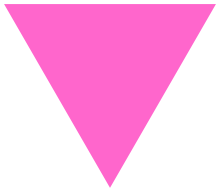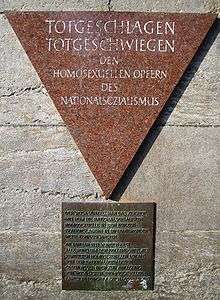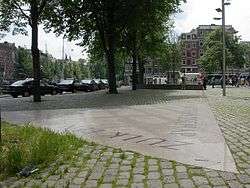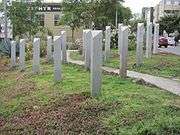Pink triangle

| LGBT symbols |
|---|
| Flags |
| Other symbols |
A pink triangle has been a symbol for various LGBT identities, initially intended as a badge of shame, but later reclaimed as a positive symbol of self-identity. In Nazi Germany in the 1930s and 1940s, it began as one of the Nazi concentration camp badges, distinguishing those imprisoned because they had been identified by authorities as homosexual men,[1] a category that also included bisexual men and transgender women.[2] In the 1970s, it was revived as a symbol of protest against homophobia, and has since been adopted by the larger LGBT community as a popular symbol of LGBT pride and the LGBT rights movement.[3][4]
History
Nazi prisoner identification
In Nazi concentration camps, each prisoner was required to wear a downward-pointing, equilateral triangular cloth badge on their chest, the color of which identified the reason for their imprisonment.[5] Early on, homosexual male prisoners were variously identified with a green triangle (indicating criminals) or red triangle (political prisoners), the number 175 (referring to Paragraph 175, the section of the German penal code criminalizing homosexual activity), or the letter A (which stood for Arschficker, literally "ass fucker").[6][7]
Later, the use of a pink triangle was established for prisoners identified as homosexual men, which also included bisexual men and transgender women.[2] (Lesbian and bisexual women and trans men were not systematically imprisoned; some were, and classified as "asocial", wearing a black triangle.)[8][9] The pink triangle was also assigned to sexual offenders, such as rapists and pedophiles.[3] If a prisoner was also identified as Jewish, the triangle was superimposed over a yellow second triangle pointing the opposite way, to resemble the Star of David like the yellow badge identifying other Jews. Prisoners wearing a pink triangle were harshly treated, even by other prisoners.[3]
While the number assigned a pink triangle in German concentration camps is hard to estimate, Richard Plant – author of The Pink Triangle: The Nazi War Against Homosexuals – gives a rough estimate of the number convicted for homosexuality "between 1933 to 1944 at between 50,000 and 63,000".[1]
After the camps were liberated at the end of the Second World War, many of the prisoners imprisoned for homosexuality were re-incarcerated by the Allied-established Federal Republic of Germany.[7] An openly homosexual man named Heinz Dörmer, for instance, served 20 years total, first in a Nazi concentration camp and then in the jails of the new Republic. The Nazi amendments to Paragraph 175, which turned homosexuality from a minor offense into a felony, remaining intact in East Germany until 1968[10] and in West Germany until 1969.[11] West Germany continued to imprison those identified as homosexual until 1994 under a revised version of the Paragraph, which still made sexual relations between men up to the age of 21 – as well as male homosexual prostitution – illegal.[12] While lawsuits seeking monetary compensation have failed, in 2002 the German government issued an official apology to the LGBT community.[13]
Rudolf Brazda, one of the last known homosexual concentration camp survivors, died on August 3, 2011 at the age of 98.[14]
Gay rights symbol
.jpg)
In the 1970s, newly active European and North American gay liberation advocates began to use the pink triangle to raise awareness of its use in Nazi Germany.[15] In 1972, gay concentration camp survivor Heinz Heger's memoir Die Männer mit dem rosa Winkel (The Men with the Pink Triangle) brought it to greater public attention.[16] In response, the German gay liberation group Homosexuelle Aktion Westberlin issued a call in 1973 for gay men to wear it as a memorial to past victims and to protest continuing discrimination.[17][18] In the 1975 movie The Rocky Horror Picture Show, the bisexual, transvestite[19][20] character Dr. Frank N. Furter wears a pink triangle badge on one of his outfits.[21] In 1976, Peter Recht, Detlef Stoffel, and Christiane Schmerl made the German documentary Rosa Winkel? Das ist doch schon lange vorbei... (Pink Triangle? That was such a long time ago...).[17] Publications such as San Francisco's Gay Sunshine and Toronto's The Body Politic promoted the pink triangle as a memorial to those who had been persecuted.[17]
In the 1980s, the pink triangle was increasingly used not just as a memorial but as a positive symbol of both self and community identity. It commonly represented both gay and lesbian identity, and was incorporated into the logos of such organizations and businesses. It was also used by individuals, sometimes discretely or ambiguously as an "insider" code unfamiliar to the general public.[17] The logo for the 1987 March on Washington for Lesbian and Gay Rights was a silhouette of the US Capitol Dome superimposed over a pink triangle.[22]
Taking a more militant tone, the AIDS Coalition To Unleash Power (ACT UP) was formed by six gay activists in New York City in 1987, and to draw attention to the disease's disproportionate impact on gay and bisexual men, and the apparent role of "genocidal" homophobia in slowing progress on medical research,[23] adopted an upward-pointing pink triangle on a black field along with the slogan "SILENCE = DEATH" as its logo.[24][25][26] Some use the triangle in this orientation as a specific "reversal" of its usage by the Nazis.[27][28][29] The Pink Panthers Movement in Denver, Colorado adopted a pink triangle with clawed panther print logo, adapted from the original Pink Panthers Patrol in New York City.
In the 1990s, a pink triangle enclosed in a green circle came to be commonly used as a symbol identifying "safe spaces" for LGBT people at work or in school.[30][31]
The pink triangle served as the basis for the "biangles", a symbol of bisexual identity which consists of pink and blue triangles overlapping in a lavender or purple area. The pink and blue symbolize either homosexuality and heterosexuality, or female and male gender, reflecting bisexuals' attraction to both.[32][33]
Monuments and memorials
The symbol of the pink triangle has been included in numerous public monuments and memorials. In 1995, after a decade of campaigning for it, a pink triangle plaque was installed at the Dachau Memorial Museum to commemorate the suffering of gay men and lesbians.[34] In 2015 a pink triangle was incorporated into Chicago's Legacy Walk.[35] It is the basis of the design of the Homomonument in Amsterdam and the Gay and Lesbian Holocaust Memorial in Sydney. In San Francisco it inspired both the Pink Triangle Park in the Castro and the 1-acre (4,000 m2) Pink Triangle on Twin Peaks that is displayed every year during Pride weekend.[36] It is also the basis for LGBT memorials in Barcelona, Sitges, and Montevideo, and the burial component of the LGBT Pink Dolphin Monument in Galveston.
Until 1985 there was an unofficial ban on placing pink triangle wreaths at the United Kingdom war memorial the Cenotaph, and such wreaths were removed as soon as they were found by officials.[37]
- Examples of memorials featuring the pink triangle
- Pink triangle (Rosa Winkel in German) memorial for gay men killed at Buchenwald.
 In the Berlin Nollendorfplatz subway station, a pink triangle plaque honors gay male victims. (Photo by: Manfred Brueckels.)
In the Berlin Nollendorfplatz subway station, a pink triangle plaque honors gay male victims. (Photo by: Manfred Brueckels.) Amsterdam's Homomonument uses pink triangles symbolically to memorialize gay men killed in the Holocaust (and also victims of anti-gay violence generally).
Amsterdam's Homomonument uses pink triangles symbolically to memorialize gay men killed in the Holocaust (and also victims of anti-gay violence generally).

See also
- Bent (play)
- Persecution of homosexuals in Nazi Germany and the Holocaust
- Gay concentration camps in Chechnya, Russia, in 2017
- Pink Triangle Trust
- Purple triangle
- Sexuality and gender identity-based cultures
- Il Rosa Nudo (Naked Rose), a film by Giovanni Coda based on Pierre Seel's life.
- Sounds from the Fog, a film by Klaus Stanjek based on Wilhelm Heckmann's biography.
- Arizona SB 1062
- National Socialist League (United States), a former neo-Nazi political party for gay men
References
- 1 2 Plant, Richard (1988). The Pink Triangle: The Nazi War against Homosexuals (revised ed.). H. Holt. p. 175. ISBN 978-0-8050-0600-1.
- 1 2 Williams, Cristan. "2008 Houston Transgender Day of Remembrance: Transgenders and Nazi Germany". tgdor.org. Retrieved 2018-08-24.
- 1 2 3 Shankar, Louis (April 19, 2017). "How the Pink Triangle Became a Symbol of Queer Resistance". HISKIND. Retrieved August 22, 2018.
- ↑ Waxman, Olivia B. (May 31, 2018). "How the Nazi Regime's Pink Triangle Symbol Was Repurposed for LGBTQ Pride". TIME. Retrieved August 22, 2018.
- ↑ See Nazi concentration camp table of inmate markings
- ↑ "Homosexuals in Nazi Germany - Collections Search - United States Holocaust Memorial Museum". collections.ushmm.org. Retrieved 2018-08-27.
- 1 2 "Homosexual Prisoners · The Era of the Holocaust ·". libapp.shadygrove.umd.edu. Retrieved 2018-08-27.
- ↑ "Queer Women and AFAB People During the Holocaust". Making Queer History. Retrieved 2018-08-24.
- ↑ "Lesbians and the Third Reich". Holocaust Encyclopedia. United States Holocaust Memorial Museum. Retrieved 24 August 2018.
- ↑ James Kirchik (February 13, 2013). "Documentary Explores Gay Life in East Germany". Der Spiegel.
- ↑ Clayton J. Whisnant (2012). Male Homosexuality in West Germany: Between Persecution and Freedom, 1945-69. pp. 201–203. ISBN 9780230355002.
- ↑ Zowie Davy; Julia Downes; Lena Eckert (2002). Bound and Unbound: Interdisciplinary Approaches to Genders and Sexualities. pp. 141–142. ISBN 978-1443810852.
- ↑ Melissa Eddy (May 18, 2002). "Germany Offers Nazi-Era Pardons". Associated Press.
- ↑ Langer, Emily (7 August 2011). "Rudolf Brazda dies; gay man who survived Nazi concentration camp was 98". Washington Post. Retrieved 22 August 2018.
- ↑ "Symbols of the Gay, Lesbian, Bisexual, and Transgender Movements". lambda.org. Lambda GLBT Community Services. 2004. Retrieved 2014-09-26.
- ↑ Jensen, Erik (2002). "The pink triangle and political consciousness: gays, lesbians, and the memory of Nazi persecution". Journal of the History of Sexuality. 11 (1 and 2).
- 1 2 3 4 Gianoulis, Tina (2004). Claude J. Summers, ed. "Pink Triangle". glbtq: An Encyclopedia of Gay, Lesbian, Bisexual, Transgender, and Queer Culture. Archived from the original on 2014-10-25. Retrieved 2014-09-26.
In the early 1970s, gay rights organizations in Germany and the United States launched campaigns to reclaim the pink triangle. In 1973 the German gay liberation group Homosexuelle Aktion Westberlin (HAW) called upon gay men to wear the pink triangle as a memorial.
- ↑ "Pink Triangle Legacies: Holocaust Memory and International Gay Rights Activism". Nursing Clio. 2017-04-20. Retrieved 2018-08-27.
- ↑ Tribune, Andrew S. Hughes South Bend. "Sexuality, doo-wop major themes in 'The Rocky Horror Show'". South Bend Tribune. Retrieved 2018-08-26.
- ↑ "The Astonishingly Non-Nonsensical Plot of The Rocky Horror Picture Show". Tor.com. 2012-10-31. Retrieved 2018-08-26.
- ↑ Nash, Tara (2017-11-30). "Rated "R" for Resistance". Queerer Things. Retrieved 2018-08-24.
- ↑ "Pink Triangle Legacies: Holocaust Memory and International Gay Rights Activism". Nursing Clio. 2017-04-20. Retrieved 2018-08-27.
- ↑ Sember, Robert; Gere, David (June 2006). "'Let the Record Show…': Art Activism and the AIDS Epidemic". American Journal of Public Health. 96 (6): 967–969. doi:10.2105/AJPH.2006.089219. ISSN 0090-0036. PMC 1470625. PMID 16670207.
- ↑ Feldman, Douglas A. and Judith Wang Miller (1998). The AIDS Crisis: A Documentary History. Greenwood Publishing Group. ISBN 0-313-28715-5. p. 176
- ↑ "SILENCE = DEATH". www.actupny.org.
- ↑ "How the Pink Triangle Became a Symbol of Queer Resistance". HISKIND Magazine. 2017-04-19. Retrieved 2018-08-27.
- ↑ "San Francisco Neighborhoods: The Castro" KQED documentary.
- ↑ "This week in history: Recognizing the history of the pink triangle". People's World. PeoplesWorld.org. Retrieved 27 April 2018.
- ↑ R. Amy Elman PhD (2010) Triangles and Tribulations:, Journal of Homosexuality, 30:3, 1-11, DOI: 10.1300/J082v30n03_01
- ↑ "Safe Space – EQUAL!". equal.org. Retrieved 2018-08-24.
- ↑ Raeburn, Nicole C. (2004). Changing Corporate America from Inside Out: Lesbian and Gay Workplace Rights. p. 209. ISBN 0-8166-3999-X.
- ↑ "ALGBTICAL". www.algbtical.org. Retrieved 2018-08-24.
- ↑ Services, LAMBDA GLBT Community. "Gay, Lesbian, Bisexual, & Transgender Symbols". www.qrd.org. Retrieved 2018-08-24.
- ↑ Brocklebank, Christopher (31 May 2011). "New memorial to gay holocaust victims to be built in Munich". Pink News. Retrieved 1 June 2011.
- ↑ "Legacy Walk unveils five new bronze memorial plaques - 2342 - Gay Lesbian Bi Trans News - Windy City Times".
- ↑ "The Pink Triangle, displayed annually on Twin Peaks in San Francisco during Pride weekend". Thepinktriangle.com. 2012-06-14. Retrieved 2013-02-12.
- ↑ "Q&A: Peter Tatchell". Lush Fresh Handmade Cosmetics.
Further reading
- An Underground Life: Memoirs of a Gay Jew in Nazi Berlin (1999) by Gad Beck (University of Wisconsin Press). ISBN 0-299-16500-0.
- The Iron Words (2014) by Michael Fridgen (Dreamlly Publishing). ISBN 978-0-615-99269-3.
- Liberation Was for Others: Memoirs of a Gay Survivor of the Nazi Holocaust (1997) by Pierre Seel (Perseus Book Group). ISBN 0-306-80756-4.
- I, Pierre Seel, Deported Homosexual: A Memoir of Nazi Terror (1995) by Pierre Seel. ISBN 0-465-04500-6.
- Heinz Heger (1994). Men With the Pink Triangle: The True, Life-And-Death Story of Homosexuals in the Nazi Death Camps. Alyson Books. ISBN 978-1-55583-006-9.
External links
| Wikimedia Commons has media related to Pink triangles. |
